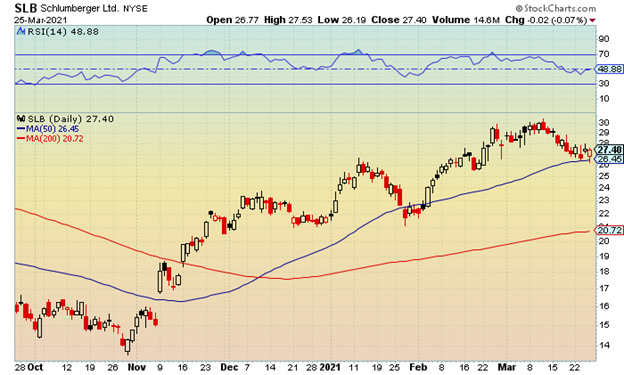Schlumberger (SLB) is the largest oilfield services industry in the world, with a presence in every energy market through its four main business segments: Reservoir Characterization, Drilling, Production, and Cameron.
The company prioritizes providing top-notch services to its customers by being a global driver in technological innovation and is better positioned than most of its competitors to take on new offshore projects in shallow water basins. Moreover, SLB’s international business looks to have stabilized more quickly than its competitors’ has, and could be the start for an earnings rebound compared to 2020.
In January, the company reported a profit of $0.22 per share on revenue of $5.5 billion, versus forecasts for $0.17 per share on of $5.25 billion. In the previous three quarters of 2020, the company topped estimates by $0.04, $0.06, and $0.01, respectively.
Regarding SLB’s macro outlook, the company’s CEO, Olivier Le Peuch, said that oil prices have risen, buoyed by recent supply-led OPEC policy, the ongoing coronavirus vaccine rollout, and multinational economic stimulus actions that are driving optimism for an oil demand recovery throughout 2021.
Le Peuch added that this sets up for oil demand to recover to 2019 levels no later than 2023—or earlier, per recent industry analyst reports—reinforcing a multiyear cycle recovery as the global economy strengthens. Moreover, he said the company is expecting more drilling activities to ramp up in the offshore resources that will meet the growing demand for crude in the world.
There are currently 30 analysts that follow SLB, with five strong buy ratings, 14 buys, nine holds, one underperform, and one sell recommendation. Following the earnings beat, three Wall Street analysts upped their ratings to buy with two price targets at $31 and $30. In early March, another analyst upgraded the price target from $31 to $35, while keeping an overweight rating on the stock.
Shares have faded from a 52-week peak of $30.42 in mid-March, with the 50-day moving average recently coming into play. There is risk towards the $25 area on a close below the $26.50 level, which would represent a possible buying opportunity. Continued closes back above $28 would signal the near-term selling pressure has abated.
SLB currently pays a $0.50 (slightly less than 2%) yearly dividend; however, this could be revisited as cash flow improves following the dividend cut from a previous $0.50 per quarter to $0.12 cents in 2Q2020.
Aggressive option traders can target the SLB June 27.50 calls that were recently trading for under $2 per contract. If shares can make a run towards $31.50 over the next few months, or by June 18, these calls would be $4 in the money for a triple-digit return.







